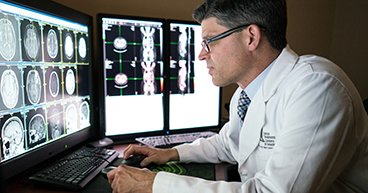
It took almost 40 years to come to market, but a treatment for advanced melanoma approved for use by the Food and Drug Administration (FDA) in February is the first in an emerging line of therapies primed to attack solid tumor cancers.
A single treatment of the new drug lifileucel (Amtagvi®) is designed to pack a punch, infusing a patient with 7.5 billion cancer-fighting cells known as tumor-infiltrating lymphocytes, or TILs. Clinical trials have shown TILs’ success in shrinking or eradicating tumors and in stopping tumor growth.
The tumor-infiltrating lymphocytes are extracted from the patient’s own tumors, replicated and multiplied outside the body and then infused back into the patient. TIL therapy is similar to chimeric antigen receptor (CAR) T-cell therapy, which is used to treat certain blood cancers. CAR T-cells are produced by harvesting T-cells from the patient’s blood and genetically engineering them in a lab so that they will attach to a specific antigen on the patient’s cancer cells and initiate an attack. The CAR T-cells are then mass produced and infused back into the patient.
In this article, we will examine:
- What are tumor-infiltrating lymphocytes?
- The TIL treatment process
- What’s the difference? TIL therapy and CAR T-cell therapy
- How is TIL therapy being used?
- What are the risks of TIL therapy for treating cancer?
- What other types of immune cells are playing a role in emerging cancer treatments?
If you’ve been diagnosed with cancer and are interested in a second opinion on your diagnosis and treatment plan, call us or chat online with a member of our team.
What are tumor-infiltrating lymphocytes?
Lymphocytes are white blood cells (T-cells and B-cells), which fight infections in the body. When cancer is present, some lymphocytes may be able to work their way into a tumor to continue the attack (tumor-infiltrating). Too often, however, there just aren’t enough TILs to make a difference and the cancer continues to grow and spread. The goal of TIL therapy is to greatly increase the number of TILs available to fight the cancer and to make them better able to handle that task.
The TIL treatment process
Currently, lifileucel is administered as part of a combination of therapies.
First, the patient undergoes surgery to remove a tumor so that tumor-infiltrating lymphocytes can be extracted from it and used to replicate billions more. Doctors typically choose a tumor that is in the easiest spot for removal. One limiting factor for TIL therapy is when tumor lesions are not easily accessible for harvesting. Those locations may include the liver, lung, brain and bone marrow.
Another limiting factor is if the TIL cultures don’t expand enough to meet the needs of the therapy, or if they are not tumor reactive. To overcome such issues, the replication process uses the immunotherapy drug interleukin-2 (IL-2) to help the TILs multiply by the billions. The TILs are also engineered to make them better able to overcome cancer resistance that may create obstacles to their effectiveness.
Before the replicated TILs are infused into the body, the patient undergoes a round of chemotherapy. “We have to give lymphocyte-depleting chemotherapy to the patients, in other words we want to knock all their T-cells down,” says Ajaz Khan, MD, Chair, Department of Medical Oncology & Therapeutics Research, City of Hope® Cancer Centers in Atlanta, Chicago and Phoenix.
Later, after the TILs are infused into the body, the patient is given several doses of IL-2, a process known as adoptive cell therapy (ACT).
“We want to give them IL-2 as soon as we give them the TIL product back. As soon as we expand that out in the lab, we'll give that to the patient. IL-2 will be a factor to create more TILs in the body, so those TILs are going directly back to the tumor,” Dr. Khan says.
What’s the difference? TIL therapy and CAR T-cell therapy
A fundamental difference between CAR T-cells and tumor-infiltrating lymphocytes is that the TILs don’t need genetic modification to be able to recognize the cancer. They are being used because they have already shown success in taking the fight to a patient’s cancer—they were just lacking the strength and sufficient reinforcements to get the job done.
“Those T-lymphocytes have already figured out a road map to get into the tumor,” Dr. Khan says. “We're not actually putting a receptor or an antigen on them. What we're doing essentially is harvesting them and really starting to proliferate them more and more.”
TIL therapy avoids two of the most dangerous side effects that may occur with CAR T-cell therapy. The first is a potentially life-threatening condition called cytokine release syndrome (CRS), which is also referred to as a cytokine storm. CRS occurs when cytokine protein molecules that stimulate immune system cells are hyperproduced, which may lead to organ failure or other serious medical issues. The other CAR T-cell side effect avoided by TIL therapy is neurotoxicity, which may cause confusion in patients and potentially lead to seizures.
Lifileucel isn’t cheap, A treatment costs an estimated $515,000, in the same ballpark as CAR T-cell therapies. It typically requires hospitalization for about two weeks, primarily because of the patient’s weakened immune system caused by the chemotherapy that is administered prior to treatment. The chemotherapy is used to create a more hospitable environment in the body for the TILs to proliferate and succeed in their mission.
How is TIL therapy being used?
Lifileucel is the only FDA-approved TIL therapy so far, and only for the treatment of advanced melanoma. Other forms of TIL therapy are undergoing clinical trials, and there have been promising results in studies involving patients with advanced stages of lung cancer, ovarian cancer, colon cancer, pancreatic cancer, head and neck cancers, and breast cancer.
But TIL therapy may have wider applications. Some research has shown positive responses are unlikely in people who have a substantial amount of cancer in their bodies. That suggests TIL therapy may be more effective at earlier stages of cancer, before tumors have grown significantly or spread.
“I think that there may be some benefit there. The challenge of the TIL therapy and giving it to earlier stage patients … is most places in the U.S. can't do it. In other words, they don't have the technology, the people, to do that,” Dr. Khan says.
More research is needed before TIL therapy is “a safer product to give where the community medical centers, regional medical centers, can give it rather than an NCI (National Cancer Institute)-designated center or a center of excellence,” Dr. Khan says. “I think that's still in question in terms of seeing if that comes to market.”
What are the risks of TIL therapy for treating cancer
Because TIL therapy returns the body’s own lymphocytes—and others made to be just like them—there have been few serious side effects reported. However, there are side effects associated with the treatments given in conjunction with TIL therapy.
“What you're seeing is the side effects of the chemotherapy, such as fever secondary to not having adequate blood counts, or we're seeing the IL-2-based toxicity, which is fluid accumulation of the lungs, fluid accumulation in the body and the torso,” Dr. Khan says. Another is capillary leak syndrome associated with IL-2, where plasma leaks out of tiny blood vessels, called capillaries.
“I think the main concerns really are the capillary leak syndrome that they reported from a recent clinical trial, and then the other issue was the neutropenia [which increases susceptibility to infection] and the low blood counts following lymphocytic bleeding chemotherapy,” he says.
Those are just some of the reasons TIL therapy currently needs to be performed in a hospital setting.
“You need to have nurses that are skilled in not just giving chemotherapy, but understanding the therapeutic implications when we give IL-2,” Dr. Khan says. “And then you need to have a lab nearby that can do all the antibody testing that you need. You need respiratory or pulmonary people. If the patient goes into capillary leak syndrome and starts to develop pulmonary edema, we need to have a cardiologist available. So, you really need a team of doctors managing these patients in the ICU and treating them, too.”
City of Hope is conducting clinical trials for TILs. Several of its centers are also seeking contracts to provide lifileucel therapy.
What other types of immune cells are playing a role in emerging cancer treatments?
Tumor-infiltrating lymphocytes and CAR T-cells are just some of the immune cells being studied as sources for new cancer treatments.
Other FDA-approved immune therapies include natural killer (NK) cellular therapies, cytokine therapies, oncolytic viruses and dendritic cell therapies, as well as immune checkpoint inhibitors, which currently are the ones most widely used, says a 2020 report in the journal Cancers out of Yale University.
A City of Hope research project has shown that one category of immune cells, called human type 2 innate lymphoid cells (ILC2s), also have the potential for use after being expanded outside of the body. During the study, such cells have been able to overpower a tumor’s defenses and eliminate malignant cells in mouse models with cancer.
The advances are being put to good use, Dr. Khan says.
“Now we have not just CAR T, but CAR NK. We have a number of varieties of these other CAR T products that are probably going to come up into Phase 1, 2 and Phase 3 trials. And so, those products may be safer to give than CAR T-cells by themselves,” Dr. Khan says.
“There's a lot of early research going on with some of these products and we're hoping to see some promise there.”
If you’ve been diagnosed with cancer and are interested in a second opinion on your diagnosis and treatment plan, call us or chat online with a member of our team.



